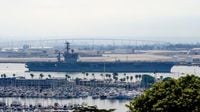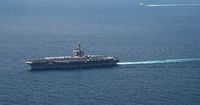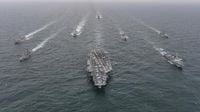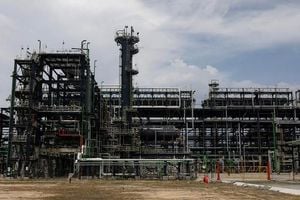Two U.S. Navy aircraft operating from the USS Nimitz crashed into the South China Sea within a span of just 30 minutes on Sunday, October 26, 2025, stirring a wave of concern and speculation across military and diplomatic circles. All five crew members aboard the MH-60R Sea Hawk helicopter and the F/A-18F Super Hornet fighter jet were rescued and are reported to be in stable condition, according to statements from the U.S. Pacific Fleet and multiple news outlets including ABC News, AP, and The Independent.
The first incident occurred at approximately 2:45 p.m. local time, when the Sea Hawk, assigned to Helicopter Maritime Strike Squadron 73 known as the “Battle Cats,” went down during routine operations from the USS Nimitz. Just half an hour later, at around 3:15 p.m., the Super Hornet—part of Strike Fighter Squadron 22, the “Fighting Redcocks”—also crashed in the same contested waters. Both crew members of the jet managed to eject safely and were quickly recovered by search-and-rescue teams from Carrier Strike Group 11, as confirmed by the U.S. Navy and reported by Straight Arrow News.
“All personnel involved are safe and in stable condition,” the Pacific Fleet emphasized in its official statement. The Navy has launched a formal investigation into the causes of both crashes, which remain unknown as of October 27, 2025. The proximity and timing of the incidents have raised eyebrows within the military aviation community and beyond, with some officials describing the events as highly unusual.
President Donald Trump, speaking to reporters aboard Air Force One during his tour of Asia, addressed the back-to-back accidents, calling them “very unusual” and offering one possible explanation. “They think it might be bad fuel. We’re gonna find out. Nothing to hide, sir,” Trump remarked, according to Reuters and The Independent. He was quick to rule out foul play, adding that the cause would likely be determined soon.
The two aircraft were conducting what the Navy described as routine operations over the South China Sea—a region that has become a flashpoint for territorial disputes and great-power competition. The waterway is vital for global trade and is regularly patrolled by U.S. naval forces conducting freedom-of-navigation operations, a practice that Beijing has repeatedly criticized as a provocation. China claims nearly the entire South China Sea, a stance that has led to ongoing tensions with several Southeast Asian nations and the United States.
Following the incidents, China’s Foreign Ministry offered humanitarian assistance, with spokesperson Guo Jiakun stating at a press conference that Beijing “will provide necessary aid from a humanitarian perspective if the U.S. asks.” However, Guo also seized the moment to criticize Washington, accusing the U.S. of “carrying out regular displays of military force in the South China Sea, increasing the risk to maritime activity, and undermining regional peace.” This dual offer of aid and criticism underscores the complex and often tense dynamics at play in the region.
The USS Nimitz, the oldest active aircraft carrier in the U.S. Navy, was returning to its home port at Naval Base Kitsap in Washington state after a months-long deployment to the Middle East. The deployment was part of the U.S. response to attacks by Yemen’s Houthi rebels on commercial shipping, a mission that has kept the vessel and its crew at the center of several international crises. This voyage marks the Nimitz’s final deployment before its scheduled decommissioning in 2026, closing the chapter on a ship first commissioned in 1975. Nimitz-class carriers, renowned for their size—nearly 1,100 feet from bow to stern—and nuclear propulsion, can operate continuously for up to 20 years without refueling.
Notably, this year has seen a series of mishaps involving U.S. Navy aircraft. According to The Independent, the F/A-18F Super Hornet lost on Sunday is the fourth such jet the Navy has lost in 2025 alone. Other incidents have plagued the USS Harry S. Truman, another aircraft carrier deployed to the Middle East. In December, the guided-missile cruiser USS Gettysburg mistakenly shot down an F/A-18 jet from the Truman. In April, a fighter jet slipped off the Truman’s hangar deck into the Red Sea, and in May, another F/A fighter jet went overboard after failing to catch the arresting cables during landing. Thankfully, no sailors lost their lives in any of these accidents, but the string of incidents has prompted ongoing investigations, the results of which have yet to be released.
The timing of the twin crashes aboard the Nimitz coincided with President Trump’s high-profile trip to Asia. The president is expected to meet with Chinese President Xi Jinping in Tokyo later in the week, following stops in Malaysia and Japan. The incidents have added a layer of complexity to already fraught U.S.-China relations, especially given the ongoing disputes over the South China Sea and the regular U.S. naval presence in the region.
While the cause of Sunday’s crashes remains undetermined, the suggestion of contaminated or “bad fuel” has been floated by the president and echoed by some in the defense community. However, until the Navy’s investigation is complete, all possibilities remain on the table. The fact that both aircraft went down within such a short window, during standard operations, has only deepened the mystery and fueled speculation.
For now, the focus remains on the safety of the crews and the ongoing investigation. The Navy has reiterated that “all personnel involved are safe and in stable condition,” a relief given the potential for tragedy in such high-risk environments. The rapid response by search-and-rescue teams and the professionalism of the crews have been credited with preventing loss of life.
As the USS Nimitz heads for home and the Navy works to uncover the causes behind these back-to-back crashes, the world watches closely. The incidents serve as a stark reminder of the risks inherent in military aviation and the geopolitical tensions that define the South China Sea. With high-level diplomatic meetings on the horizon and investigations underway, the story is far from over.






